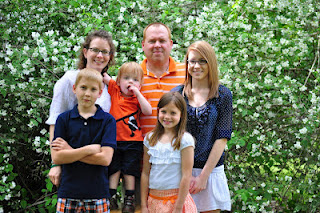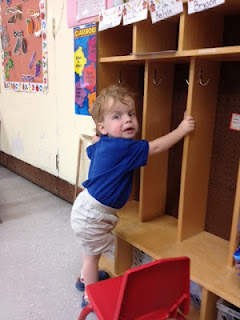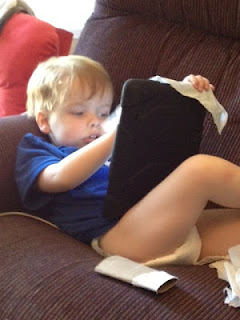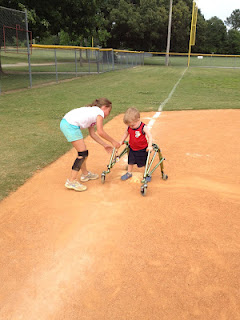An Interview with Kim Wilson
This week we’re interviewing Kim Wilson, who writes the blog Celebrating Inchstones. Kim has four kids, the youngest of whom has mitochondrial myopathy. This is a disease caused by a genetic mutation that affects the mitochondria in the body’s cells. As a result, Asa has trouble producing the sounds needed to make words. However, Asa is able to understand much of what is said to him, and he can make his wishes known in other ways. In our interview, Kim discusses her son’s speech therapy techniques and shares her experience navigating the special education process.
Can you tell us a bit about mitochondrial myopathy and how it affects Asa’s speech and language development?
Every cell (except red blood cells) in our bodies have mitochondria. Mitochondria are like tiny power plants that create energy for our cells which in turn will power our bodies. When those power plants don’t work properly our cells can’t function and our bodies suffer. Any bodily system can be affected but the systems that need the most energy are the muscles, heart, and brain. Myopathy just means that Asa’s muscles are his most affected system. Because Asa’s muscles are so affected he doesn’t use his tongue, lips, or facial muscles in a normal way to produce words or many sounds. While he may not be verbal he is vocal! He has many squeals, screams and grunts that have meaning. His receptive language is also quite good. He follows directions and even picks up on things in conversations that we are trying to sneak by him!
Asa knows a few signs for basic words. What other methods of communication has he been able to use?
Asa does know a few signs. His fine motor skills are delayed too and most of his signs are versions he has created using the skills he has. I’ve been told signing wouldn’t be an effective way for him to communicate because his signs are “muffled” or “slurred”.
He also uses an iPad to communicate. I love the Yes/No app because it’s quick and simple. We can take a picture of 2 choices and he can choose the one he likes best. We also use My First AAC. We started out with a PECS system and Asa picked up on the system quickly, but it was too cumbersome for him. He mostly communicates by vocalizing and we just try to decide what he needs in the moment.
Asa sees a speech therapist in addition to a couple of other specialists. Which speech therapy techniques has his SLP been using with him? Do you also work on speech therapy at home with him?
In therapy, Asa works a lot on pointing to make selections. He tends to just tap around rather than looking and making a meaningful choice. They work on repeating sounds back and forth. They work on increasing his receptive skills too. We also do these things at home. We use an echo microphone to repeat and even take advantage of echoing places like empty rooms, stairwells or our backyard to practice echoing sounds. I’ve just discovered that having Asa practice drinking from a water bottle is teaching him to use his mouth muscles to create a “kissing” kind of lips motion. Asa usually has a slightly open mouth so this is good practice.
You’ve mentioned that Asa will be going into pre-K next year. The transition to a full day must be stressful. What’s your experience in working with Asa’s teachers been like? Have they been able to accommodate his needs?
School has been quite a transition! I’m very nervous about what the full day program will hold for him. To be honest, I feel his therapies have continued to be great but meeting his IEP goals for the classroom have been lacking. I found that most often he was left out of circle time or center time activities because he was quieter and happier to play alone in his own area. I had a hard time getting his teachers to see that Asa needed extra help and support while working on class activities. For instance, the teacher didn’t want to use a Rifton chair with a tray when having Asa doing table activities or even testing. He is able to sit in a regular chair but he greatly benefits from having proper foot rests vs. dangling legs, straps help him keep his upright posture vs. slouching to the edge of his seat, and the tray keeps everything at the proper height for him to work at his best. Getting his teachers to use equipment so he could best excel was a bit testing. I hope a more detailed IEP will help for the full day program next year.
Special education is practically synonymous with paperwork. How do you get organized and prepare for Asa’s IEP meetings? Do you bring an attorney?
I’m just awful with paperwork and IEPs make me nervous! I do get to see and talk to Asa’s teachers and therapist often since I take him and pick him up often. I feel that we address most of his needs during these times. It’s when we sit around a large table and pass copies of copies of copies around that I get nervous. I bring his current IEP, any new medical testings or info that might be needed and a list of questions or issues I’d like addressed. I also like to have a more personalized introduction letter, including a picture, to give to anyone who might be new to the team. Asa is a very different little boy in real life than the one that comes across on his tests or IEP goals! And I’ve never brought an attorney or even an advocate with me. This may change as we enter “real” school though!
What advice would you give to parents who meet with resistance with the IEP team?
I don’t have any advice for parents meeting resistance because I’ve never really dealt with that before myself! I’ve taken a class offered by STEP (Support and Training for Exceptional Parents) that covered special education law and our rights. I also know that our local ARC advocate is available if needed.
_________________________________________________________________________________________________
Thank you so much, Kim, for sharing your family’s story! Be sure to check out Kim’s blog, in which she chronicles Asa’s journey with mitochondrial myopathy.






